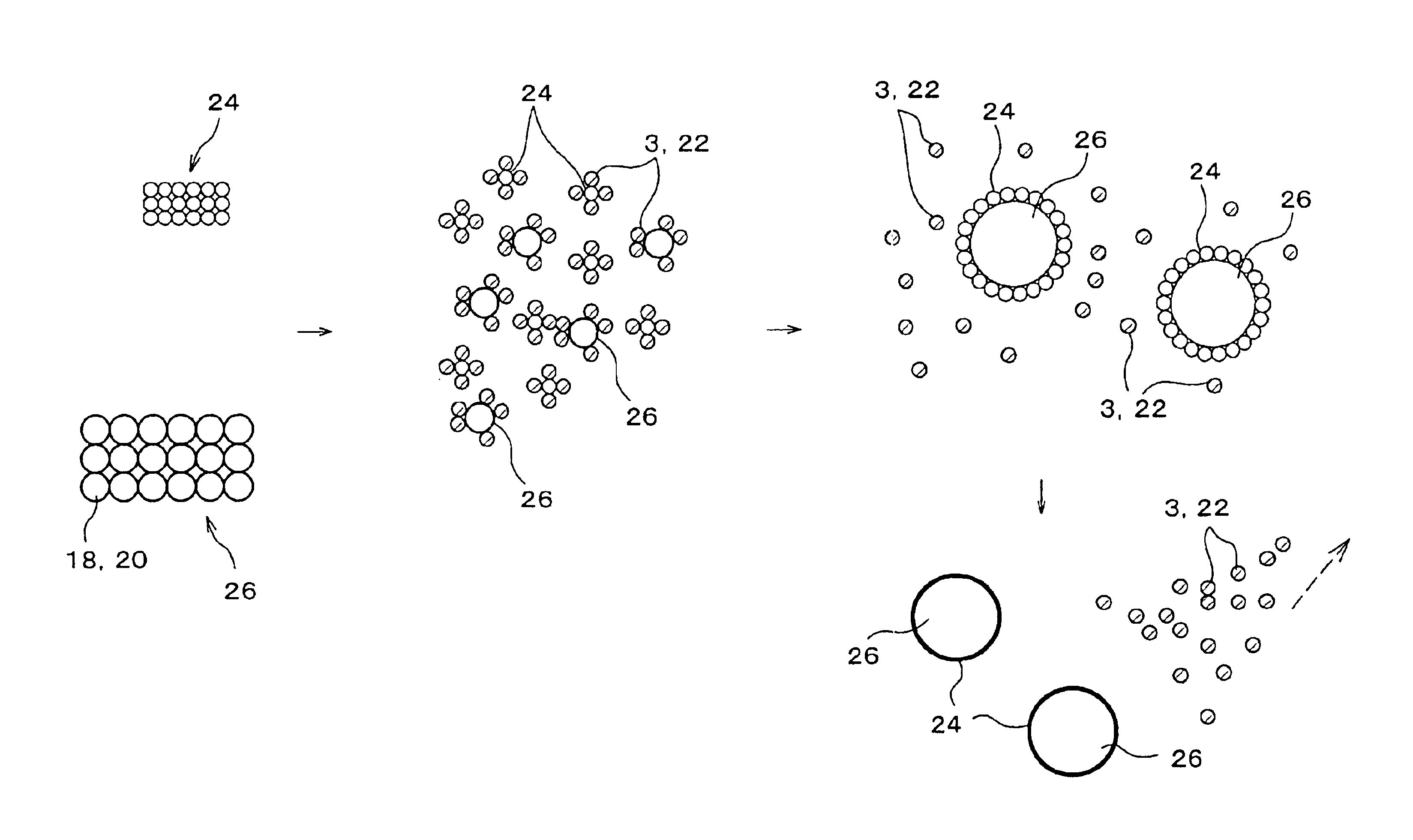Toner and manufacturing method thereof
a technology of toner and manufacturing method, which is applied in the field of toner, can solve the problems of reducing the coloring power of coloring agents, requiring a greater application of heat for thermal fixation so as to achieve the effect of maintaining the dispersibility of coloring agents, achieving desirable image quality, and increasing the content of coloring agents in toner
- Summary
- Abstract
- Description
- Claims
- Application Information
AI Technical Summary
Benefits of technology
Problems solved by technology
Method used
Image
Examples
example 1
[0152]The toner manufacturing apparatus as shown in FIG. 1 was used for producing the toner of a present example 1. The volumetric capacity of the reactor 7 was 1000 cm3, for example. Carbon dioxide was used for the gas as the SCF 22 in the present example 1, while Methanol (a common reagent sold on the market) was used for the entrainer 3.
[0153]For the binding resin component 18, a polyester resin (provided by Sanyo Chemical Industries Co., Ltd., Product Name: EP 208) was used by 50 g. Carbon Black (provided by Mitsubishi Chemical Co., Ltd., Product Name: MA 100) as the coloring agent component 20 was added in the reactor 7 in advance by 10% to 30% by weight with respect to 100% by weight of the polyester resin. Note that, the entrainer 3 was incompatible with the binding resin component 18 at ordinary temperature and ordinary pressure.
[0154]The carbon dioxide gas supplied from the gas cylinder 1 was pressurized by the pressurizing pump 2, then was introduced into the reactor 7 via...
example 2
[0162]While the example 1 used the binding resin component 18 prepared from the raw material that was already in a resin (a polymer) form, it is also possible to use monomers for the raw material of the binding resin component 18, as described below, for producing the toner of the present invention.
[0163]In a present example 2, polymethyl methacrylate (PMMA) was selected to be the binding resin component 18. Thus, 50 g of methyl methacrylate monomer was added as a raw material of the PMMA in the reactor 7. Also added was azobis-isobutyl nitrile (AIBN) in about 1% by weight as a polymerization initiator. As in the above case, pressurized carbon dioxide was introduced into the reactor 7, to create a first supercritical state. Here, the conditions in the reactor 7 were set as follows: the temperature was in the range from 330K to 340K, the pressure was at about 20 MPa.
[0164]The state was maintained for one to two hours. The polymerization was carried out in the first supercritical stat...
example 3
[0166]When a color toner of the present invention is produced, the respective pigments, which were previously named in the embodiment section of the present invention, may be used for the coloring agent component 20. In a present example 3, a toner with magenta color is discussed, for exemplification. The present example 3 employed the same manufacturing apparatus and method as the example 1 for producing the color toner, except that carmin 6B (a pigment) was used for the coloring agent component 20, in a quantity in the range between 10% and 30% by weight.
[0167]Here, the coloring agent component 20 could be provided in the form of a masterbatch, in which pigments were dispersed in the binding resin component 18 in high concentration. The quantity of masterbatch to be added was set so that the quantity of the coloring agent component 20 was in the range between 10% and 30% by weight. In addition, the resin component of the masterbatch was preferred to be the same resin as the bindin...
PUM
 Login to View More
Login to View More Abstract
Description
Claims
Application Information
 Login to View More
Login to View More - R&D
- Intellectual Property
- Life Sciences
- Materials
- Tech Scout
- Unparalleled Data Quality
- Higher Quality Content
- 60% Fewer Hallucinations
Browse by: Latest US Patents, China's latest patents, Technical Efficacy Thesaurus, Application Domain, Technology Topic, Popular Technical Reports.
© 2025 PatSnap. All rights reserved.Legal|Privacy policy|Modern Slavery Act Transparency Statement|Sitemap|About US| Contact US: help@patsnap.com



